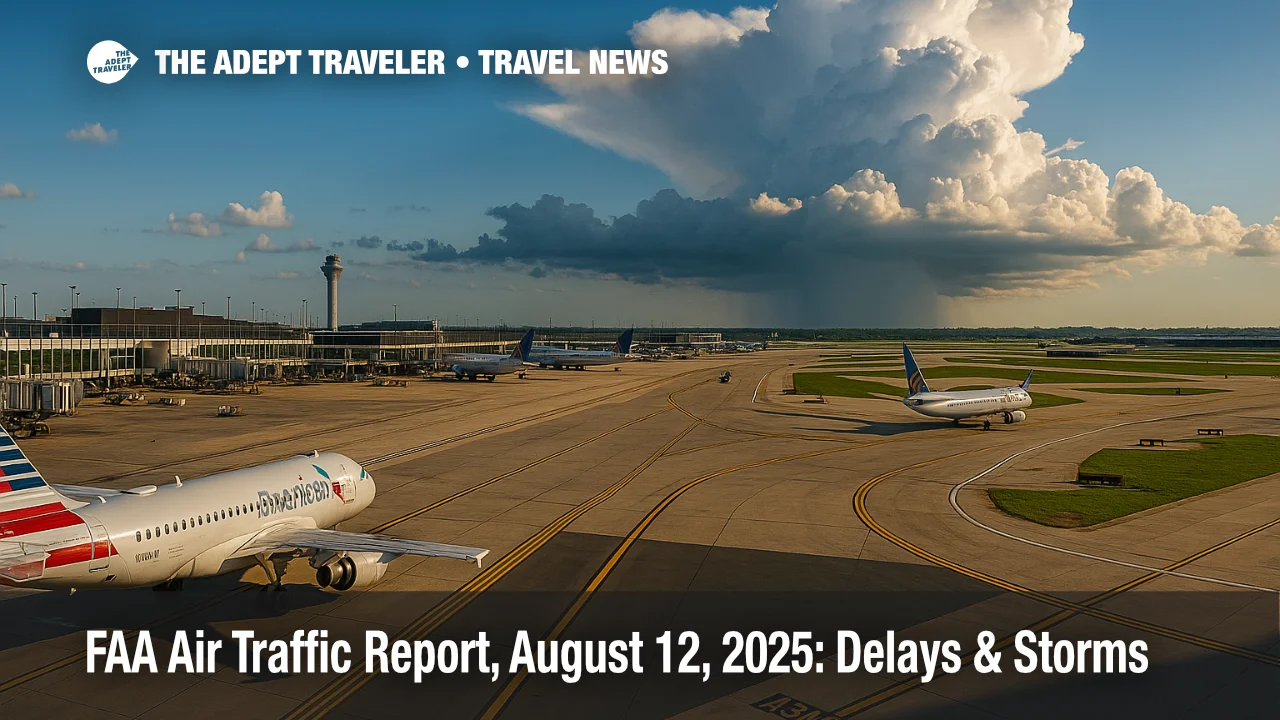FAA Air Traffic Report, August 12, 2025: Delays & Storms

Morning thunderstorms briefly triggered ground stops in the Chicago TRACON before clearing, affecting O'Hare International Airport (ORD) and Midway International Airport (MDW). Charlotte Douglas International Airport (CLT) entered a time-boxed ground stop, and Philadelphia International Airport (PHL) ran a ground delay program tied to runway work. The FAA's operations plan lists additional hubs at risk for ground stops or delay programs later today. Low clouds are also slowing arrivals in San Francisco and parts of Southern California.
Key Points
- Why it matters: Early hub constraints ripple through connections and crew rotations.
- Travel impact: CLT ground stop into mid-morning; PHL ground delay program into late morning.
- What's next: GS or GDP possible at Florida, San Francisco, Atlanta, Houston, and Dallas hubs.
- Oceanic AR8 and L452 closed; select Gulf Q and Y routes closed.
- SFO metered with TBFM until ceilings improve near midday.
Snapshot
The FAA's midday operations plan reports that the Chicago ground stops were canceled after storms moved out. CLT was under a ground stop until about 930 a.m. Central. PHL operated a ground delay program until about 1129 a.m. Central due to runway maintenance. The plan highlights possible ground stops or delay programs after 1000 a.m. Central for Miami International Airport (MIA), Fort Lauderdale-Hollywood International Airport (FLL), Palm Beach International Airport (PBI), and San Francisco International Airport (SFO). Atlanta risk begins after 100 p.m. Central. Orlando, Tampa, Houston, and Dallas risks begin after 200 to 300 p.m. Central. Chicago remains on watch into the evening.
Background
A ground stop holds certain departures to an airport or airspace until conditions improve, often for weather or configuration changes. It overrides other traffic management initiatives and typically occurs with little warning. A ground delay program meters arrivals using Estimated Departure Clearance Times, which assign arrival slots to match reduced capacity. Both are administered through the Air Traffic Control System Command Center and published via the Advisories Database and operations plan. FAA guidance notes that ground stops are short-term controls, while ground delay programs handle longer-duration capacity mismatches and reduce airborne holding.
Latest Developments
Chicago Ground Stops Canceled; Charlotte and Philadelphia Constrained
The operations plan states the C90 ground stops were canceled once storms moved out of the terminal area. CLT carried an active ground stop until 930 a.m. Central. PHL's ground delay program was active into late morning due to runway maintenance. San Francisco arrivals are being metered with TBFM scheduling, with ceilings forecast to improve around 1230 p.m. Central. The plan also notes a WestJet ground stop was issued and canceled at the carrier's request. Details and timing appear in the FAA's Current Operations Plan Advisory.
Watch List Windows for Major U.S. Hubs
The plan lists GS or GDP possible after the following Central times: MIA, FLL, and PBI after 1000 a.m.; SFO after 1000 a.m.; Hartsfield-Jackson Atlanta International Airport (ATL) after 100 p.m.; Orlando International Airport (MCO) and Tampa International Airport (TPA) after 200 p.m.; George Bush Intercontinental Airport (IAH) and William P. Hobby Airport (HOU) after 200 p.m.; Dallas Love Field (DAL) and Dallas Fort Worth International Airport (DFW) after 300 p.m. ORD and MDW remain on watch through about 9:00 p.m. Central. The FAA's Daily Air Traffic Report aligns with these risk areas, citing low clouds in ATL and SFO and thunderstorms across Florida and Texas.
Oceanic and Gulf Routes Closed by Storms
Thunderstorms have closed trans-Atlantic AR8 and L452, with updates scheduled midday. In the Gulf, Q100, Q102, Y280, and Y290 are closed for weather, with later updates expected. The en route section also flags broader convective constraints across several Air Route Traffic Control Centers. As a result, crews and dispatchers should expect tactical reroutes, CDR usage, and potential SWAP along the East and Gulf Coasts as cells evolve. The FAA's NAS Status map provides the live system picture.
Analysis
Today's pattern reflects a common summer sequence. Morning convection near a major hub triggers brief ground stops to protect arrival flows, then the system transitions to metering and tactical reroutes as the convective line disperses. Canceling the Chicago stops early helps preserve mid-day banks at O'Hare International Airport (ORD) and Midway International Airport (MDW), yet residual spacing can still push connections. The simultaneous runway work program at Philadelphia International Airport (PHL) adds another metering point, a reminder that construction can constrain capacity even when weather improves.
San Francisco International Airport (SFO) often sees low ceilings during marine-layer mornings. TBFM metering bridges the gap until ceilings lift and arrival rates normalize. The watch list for Miami International Airport (MIA), Fort Lauderdale-Hollywood International Airport (FLL), and Palm Beach International Airport (PBI) signals typical afternoon storm risk in South Florida, where escape routes and SWAP are common. Similar cues for Hartsfield-Jackson Atlanta International Airport (ATL), Orlando International Airport (MCO), Tampa International Airport (TPA), George Bush Intercontinental Airport (IAH), William P. Hobby Airport (HOU), Dallas Love Field (DAL), and Dallas Fort Worth International Airport (DFW) suggest a classic late-day convective footprint. Closed oceanic and Gulf routes add mileage and complexity for Caribbean, Mexico, and trans-Atlantic flows, even where local weather appears benign.
Final Thoughts
If you are booked through Chicago, Philadelphia, or Charlotte today, leave extra connection time and monitor your airline app for any EDCT changes. Florida, Atlanta, Houston, and Dallas banks may see recovery pushes into the evening if storms persist. The FAA air traffic report underscores how early weather, construction, and route closures can ripple through the network within hours.
